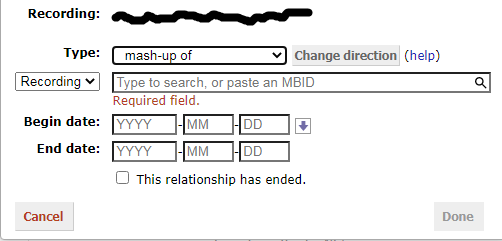Hello, there is this mashup on YouTube: Buddha vs Never say goodbye (Hardwell Mashup) - YouTube
Also, there is this release: Never Say Goodbye Buddha [Mix Cut] - Hardwell Mashup - song by Holl & Rush, Tom & Jame, Hardwell, Dyro, Bright Lights | Spotify (Also available on YouTube Music).
There is also this recording: Recording “Buddha / Never Say Goodbye” by Holl & Rush vs Tom & Jame / Hardwell & Dyro feat. Bright Lights - MusicBrainz
I am not sure how to submit the AcousID for the longer mashup of length 4:24. Should i just submit the AcoustId of the 4:24 recording to the one with length 2:33? Should I add a recording of the 4:24 length to some new artist based on this YT user Carlos Vidal? Then add the 4:24 recording to him, then add an unofficial release, then link both to a new work called “Buddha / Never say goodbye” from Hardwell?
I am not really sure where this user got the 4:24 mashup, there are many more on his channel, no idea if he did it.
P.S.: There are also other users who make such “unofficial” mashups.
EDIT: What i’m worried about is that due to the default 70% match of Picard, it is possible that the longer track might not be found. (Though I never tested that.)
Different lengths, different Recordings, separate AcoustIDs.
They may link to the same Work, but otherwise they are different things.
The YouTube track should have a totally separate Recording linked. Listed as a standalone recording of its own with the Masher-Upper getting some of the credit.
The Spotify recording looks the same as the Musicbrainz recording you have found. Though currently that Spotify Album is not in Musicbrainz as a Release as it only has 22 tracks and you are linking to a 27 track CD. The Spotify album needs adding as a Release (but not really important here).
So a simple answer - No, don’t add an AcoustID for 4:24 mash-up to the original 2:33 track. You have a new unique recording.
1 Like
Can a recording be part of/have two works? Say a work for Tom & Jame’s “Buddha” and another work for Hardwell & Dyro’s “Never say goodbye”, and then base both mash-ups on them, or the mashup is a different work?
1 Like
Yes. There is a way of doing it. You link to both “recordings” to show what it is a combination of. In this example, you make a NEW recording. And then make a relationship to show your new recording is a “mash-up of” the two source recordings.

Did the YouTube guy “Carlos Vidal” create this mix? Then you credit him as the artist who made the recording. Though I am always a little confused with the credits here as sometimes you have a “vs” added to include the original recording artists.
2 Likes
